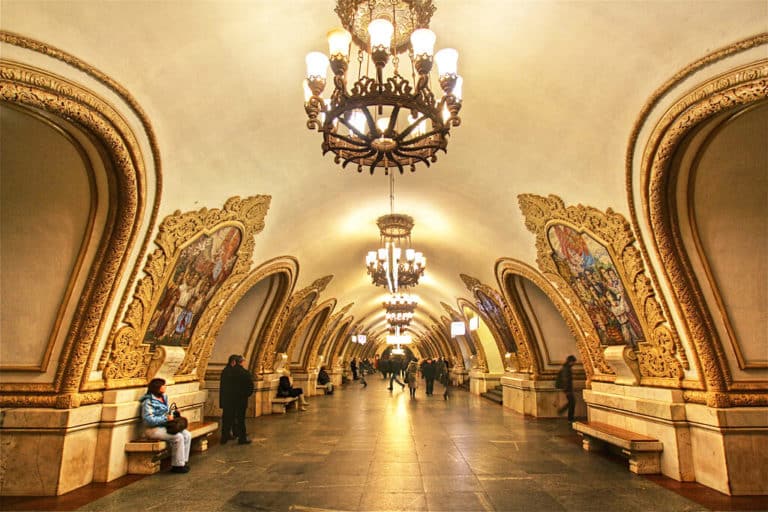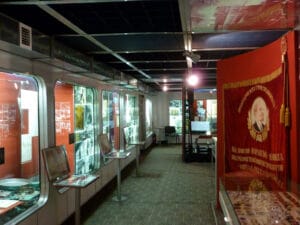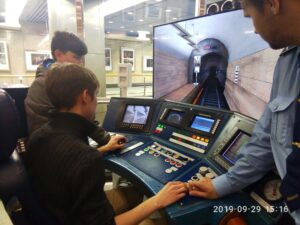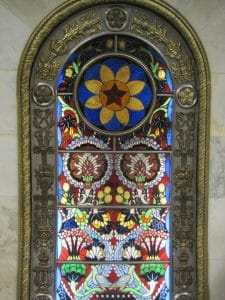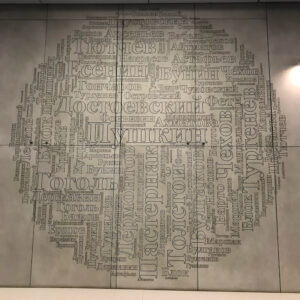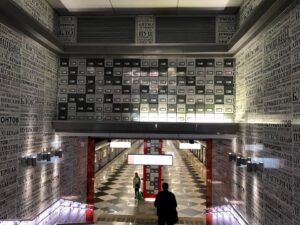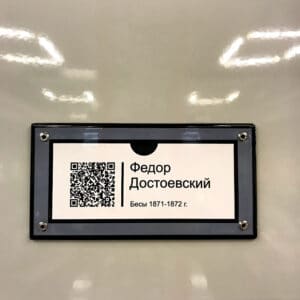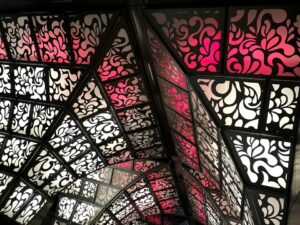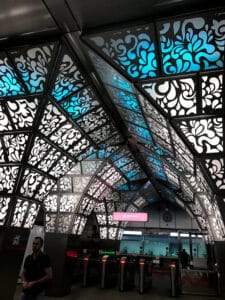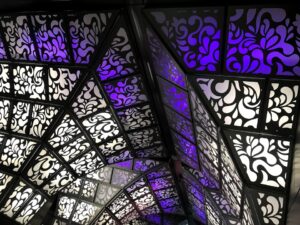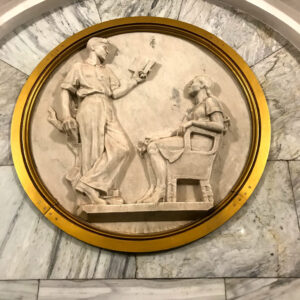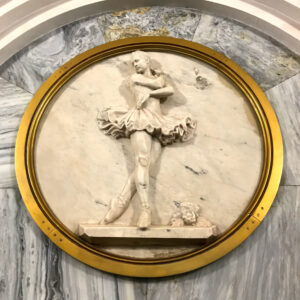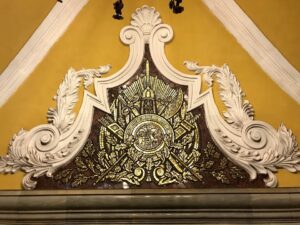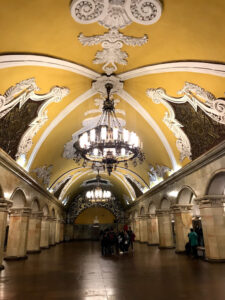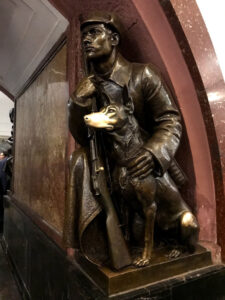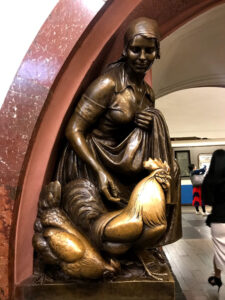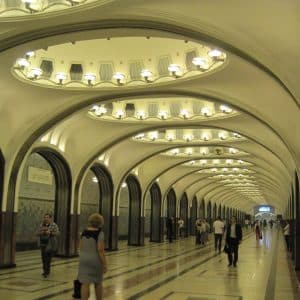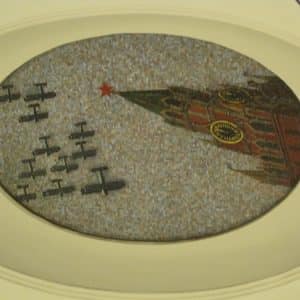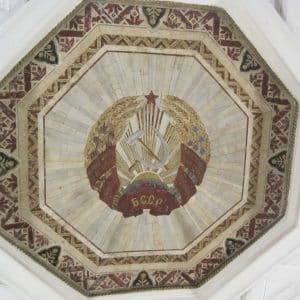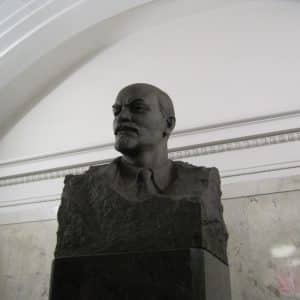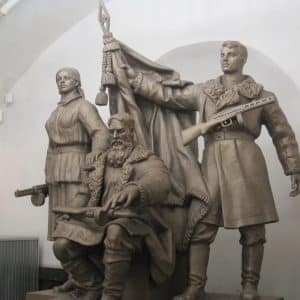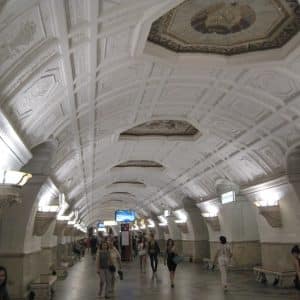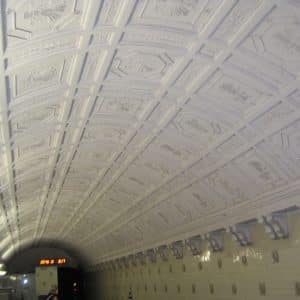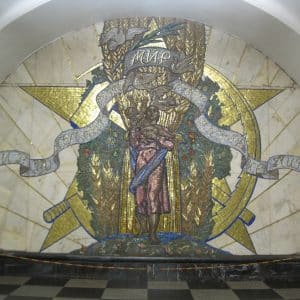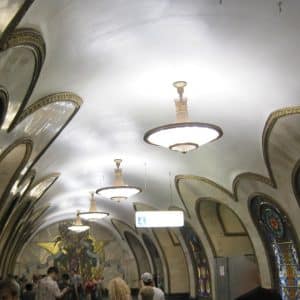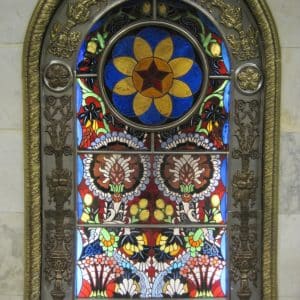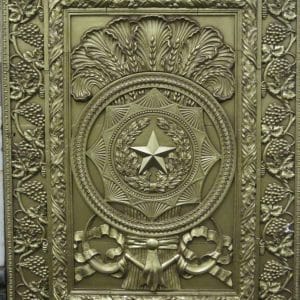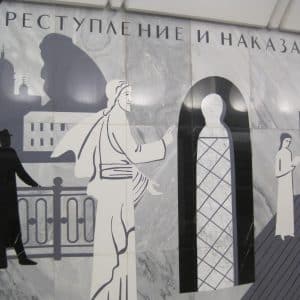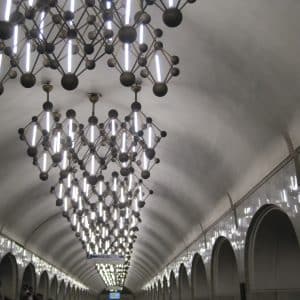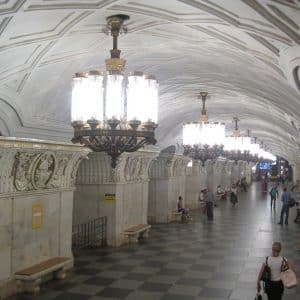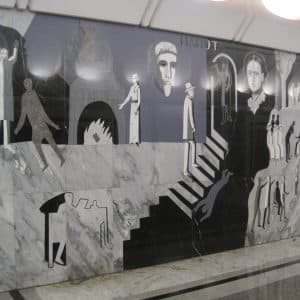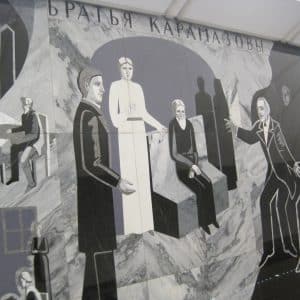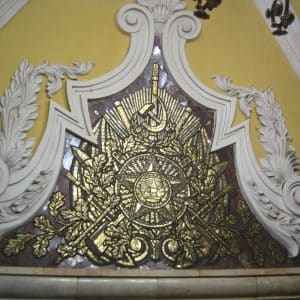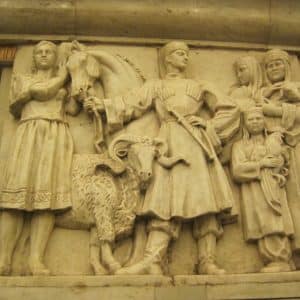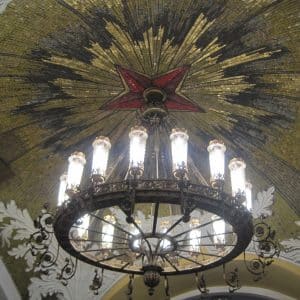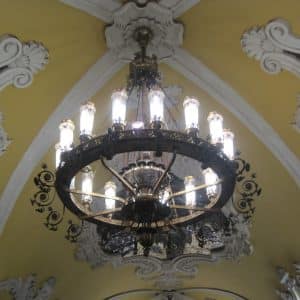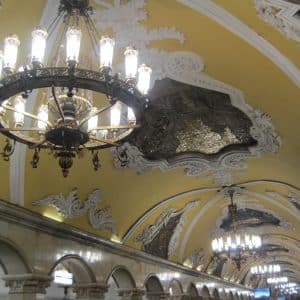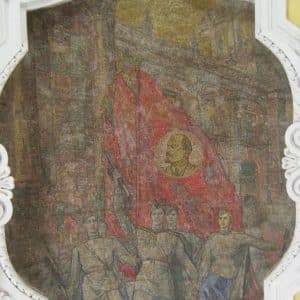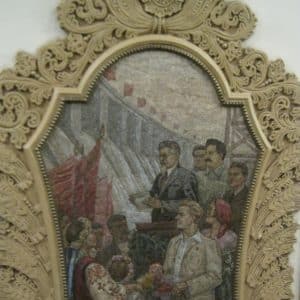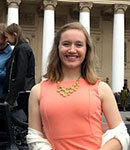Even if you’ve seen pictures, you’re not prepared for the Moscow Metro System. For visitors, one of the great surprises of this historical city is discovering the beauty and cleanliness of its underground palaces. It’s worth a few hours in the afternoon or late evening (avoid rush hour 4-7) to ride around and see the amazing interiors of this famous system. You’ll see, especially with the older stations (center and ring stations) that an immense amount of thought and creativity went into making each station unique, with a specific theme and elaborate artwork.
A Short Introduction to the Moscow Metro
By Sarah Parker
The Moscow Metro is also internationally renowned for its efficiency. Every day 6-9 million passengers use the Moscow Metro.
It’s not by chance that the art and beauty of the Metro are awe-inspiring. The construction project was the culmination of Soviet and Stalinist ideals. It was an early example of the industrialization, modernization, and shared community spaces that had been promised to the people. Stalin, who first authorized its construction, said that the proletariat entering the metro should feel like nobility. There is a distinctive palatial, even reverential feel to the stations, which was intended to emphasize the light of the sun, and give patrons the feel of their светлое будущее (radiant future.) The art of the original stations embodies the efforts and achievements of the Soviet Man, and the revolutionaries who predated him. At Площадь Революции (Revolution Square), for example, there are statues of all the various citizens (including animals) who aided in The Revolution. You will notice discoloration on statues where people have touched them for good luck.
The Moscow Metro opened officially in 1935, with 13 stations, mostly along the current red line (Сокольническая Линия), with a spur along the current blue line. The major part of the original system ran through the city center, with termini at the city’s two major parks – Sokolniki in the north, and Park Kultury in the south. Citywide celebrations, parades, concerts, and awards given to workers accompanied the opening. Today, it has already expanded to 14 lines, and 236 stations, with much more development being planned over the next several years. Find out more about its development and see lots of historical maps here.
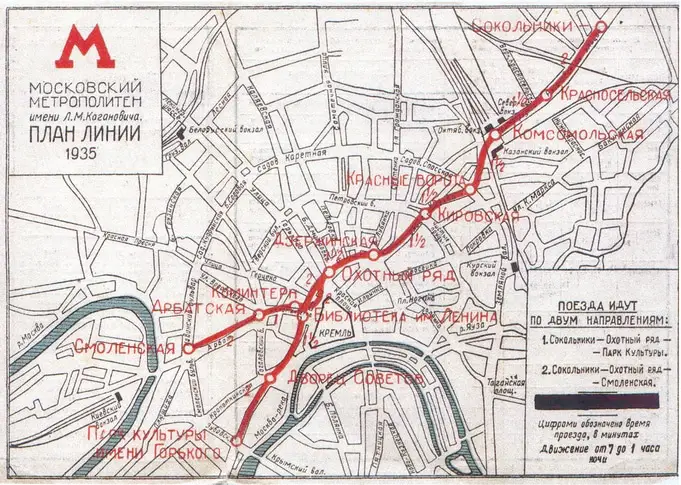
The Museum of the Moscow Metro
By Katherine Hallin
For those that really want to get to know the Moscow Metro, it has its own museum!
The Public Museum of the Moscow Metro is an immersive look into the history, engineering, and continuity of the Moscow Metro system. It is open every day from 10:00 AM to 6:00 PM and located in the second-level of the modern Vystavochnaya Station, near the towering Moscow City skyscraper complex in central Moscow.
The sleek, functional architecture of the small museum houses artifacts and displays that commemorate not only the metro’s construction, engineering, and design, but also its political and cultural significance and decades-long service to Moscow’s citizens, from everyday transportation to wartime shelter.
This free, public museum originally opened at the Moscow Sportivnaya station in 1967. It moved to its current location in 2016.
Designed by Olga Farstova, Aleksandr Vigdorov, and Leonid Borzenkov, the long, arched gallery of the Vysavochnaya Station is itself an introduction to the museum’s content. Although a futuristic departure from the often lavish, classical interiors of the Moscow Metro’s early stations and the functional pragmatic design of its later Soviet stations, Vystavochnaya’s daring modern aesthetic educates visitors on the importance of both design and technological progression to the identity of the Moscow underground.
Although not translated to English, the exhibits themselves chronicle the nearly ninety years of the Moscow’s metro history, starting with the opening in 1935 under the Stalin regime. Exhibits include older metro signs, transport employee uniforms, actual metro engines, photographs, documents, and other object collections. Together, they paint a picture of the infrastructure as woven into the cultural and municipal life of Moscow as a monument to and for the people.
The museum offers screenings of films in which the Moscow Metro is featured. There are also Subway Club meetings for Moscow youth which offer quests and other activities. The museum space is additionally one of vocational education and training, with a full-size metro simulator in which visitors can how learn how to pilot a train (available to visitors on Sundays from noon to 6:00 PM or by appointment). It’s attached to a fullsize metro car, just to make it seem a bit more lifelike. This merges with the functions of the Vocational Center, also operated by the Metro, in the Vystavochnaya Station lobby.
Professional guides are also available from the facility if reserved ahead of time.
About 20 meters away from the museum there is a metro souvenir store, which sells uniquely decorated and shaped troikas (the already iconic metro electronic pass) as well as stationery, shirts, and other cool stuff to take home with out.
This mix of history, culture, engineering, and functionality creates a welcoming but awe-inspiring introduction to the metro for visitors. Run by the Moscow Metro, which in turn is run by the Moscow city government and the Russian State, it should not be surprising that this discursive meld becomes a celebration of Russian ingenuity. The metro is presented as a marvel in its construction and beauty and in the heroism of those who designed and built it. However, given the undeniable efficiency and general splendor of the metro, the museum is convincing in its arguments that these grand feats of engineering have achieved much larger goals of public service.
Fun Facts about the Moscow Metro
By Sarah Parker
- The original excavation revealed the Moscow Metro would be very difficult to build, because of the soft makeup of the soil and the presence of underground water. Just in one stretch, (between Sokolniki and Okhoty Ryad) there were four underground rivers. This is one reason why the stations are very deep.
-
Artwork at Novoslobodskaya Though it had been planned and worked on since 1902, the vast majority of excavating, tunneling, concreting, and track laying was accomplished in a very concentrated amount of time, between 1933-1935.
- The Moscow Metro officially employed a peak of 75,000 people in 1934, though it is thought that some of the labor force was augmented with prison labor. Almost all the excavation was done with hand tools.
- During WWII the stations of the metro were sometimes used as an underground shelter. During the cold war, some areas were fitted with life-sustaining systems to be used as a nuclear bomb shelters.
- It is now a more-or-less open secret that there is another, much smaller metro line, metro 2, which was built in case of emergency, to evacuate key military personnel and some civilians. Entrances to this system are located under Moscow State University, the Russian State Library, the Kremlin, and other important state buildings.
- Average speed of trains along the metro is about 42 km/hr (about 29 mph)
- The deepest Moscow Metro station and longest escalator are both located at Park Pobedy on the Blue Line. It is located 276 feet below the surface.
- The Moscow Metro was exalted as a symbol of Socialism, and the Soviet Man was exalted within it. Riders were encouraged to dress nicely, not use foul language, and to behave themselves like upstanding citizens.
- There are no garbage bins on the platforms where the trains go by. They were removed as possible safety threats.
- It is rare to see people eating or drinking in the Metro. Russians will generally avoid eating in enclosed public spaces which are not intended for eating as it is believed to be unsanitary.
Question: Why are the Moscow Metro Doors so Heavy?
Translated by Caroline Barrow from the Russian original
The size, thickness, and most importantly, the weight of the metro entrance doors have not changed for more than half a century. During that time, Muscovites have learned to use their elbows as battering rams and gotten used to ducking and dodging the hundreds of pounds of metal and glass that come whistling past them. A few have even taught themselves to hold the metro doors for other passengers. But all this time, we continue to wonder: “why are the doors so heavy?” To find the following answer, have the Metro management authorize the answer, and then send it to us by fax, took officials at the Moscow Metro a full month.
Answer from the Moscow Metro Administration:
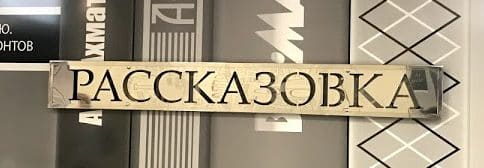
The metro has seen three types of doors: First, there was wood – the old model. Then, in the 1960s, doors made of glass and metal appeared. In 2007, we began installing doors made of stainless steel.
The heaviest of these doors are the wooden ones; they weigh around 110 kilograms while the glass doors weigh only 80 kilograms. The designers followed certain standards, which prescribed requirements for strength, durability, and so on. However, about the weight of the door panel, there simply were no requirements. Therefore, the designers did not even think about it. In the metro, there are door-making workshops, but we only make non-standard models there, in case doors larger than the regular size are needed. Most of the doors are made by third-party contractors, chosen by tender.
Accidents with the doors, unfortunately, happen, but not too often. They are often heavily reported in the media. By the way, I hasten to remind everyone, that metro is a form of transportation service that carries an increased chance of risk. Even the government has acknowledged this. So, when using the metro, be especially careful. Statistics show that all accidents and injuries in the metro occur because passengers themselves violate the basic rules of safety.
Question: Why do the Escalator and Handrails Move at Different Speeds?
Translated by Caroline Barrow from the Russian original
In the Moscow Metro, the escalator’s handrails move a little faster or a little slower than the escalator. There is a theory about this: this causes passengers to have to occasionally adjust their grip, and thus does not give the chance for overly tired passengers to fall asleep. The Kyiv edition of the village has found out whether or not this is a fact. The Moscow and Kyiv metros and escalators were built with the same technology, so the answer from Kyiv should hold true for Moscow.
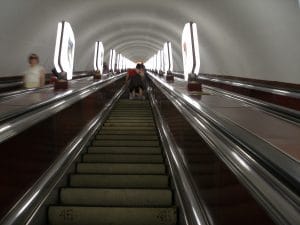
Answer from Nikolai Andrushchik, Head of the Escalator Service:
The different speeds are related to the escalator’s construction. The track consists of steps on a carrier chain, which moves via gears and an electric motor. The handrails move via the rotation of the drive unit. Over time, the drive unit wears out, and its diameter decreases. As a consequence, handrails begin to move at a different rate, but the speeds should not differ by more than 2%. We monitor this. A slight speed difference is not a problem and is not dangerous.
The different speeds serve no purpose. Occasionally, we simply laugh about the myth that the purpose is so that passengers do not sleep on the escalator, because in reality this would do little to help.
Five Moscow Metro Stations That Show Its Diversity
By Helen McHenry
Much more than just the city’s premier mode of transportation, the Moscow Metro is a tourist attraction in its own right. Each station is unique, and as new ones continue to be added, they represent over 60 years of styles and history. Below I have spotlighted five of the most interesting stations I saw during my stay in Moscow, as well as where they are located and with pictures of some of their main attractions.

Name: Рассказовка (Rasskazovka)
Location: Yellow Line 8A
Attraction: This literary-themed station is one of Moscow’s newest additions. Sporting black and white walls lined with the names of famous Russian authors, this station sparks with modernity – metallic squares reminiscent of filing cabinets hold QR codes linked to web pages about each author.

Name: Новопеределкино (Novoperedelkino)
Location: Yellow Line 8A
Attraction: A stop away from Рассказовка, this station contrasts a black and white frame with mesmerizing lights of all colors of the rainbow. I easily allowed multiple trains to come and go as I watched them change.

Name: Парк Культуры (Park Kultury)
Location: Brown Line 5
Attraction: Each pillar is adorned with a circular relief, upon which various scenes of Soviet life and talent are displayed.

Name: Комсомольская (Komsomolskaya)
Location: Brown Line 5
Attraction: The main atrium is painted a vibrant mustard, upon which white molding is juxtaposed by dark mosaics in gold and brown.

Name: Площадь Революции (Ploshchad Revolyutsii)
Location: Dark Blue Line 3
Attraction: The halls of this metro station are lined with bronze statues of Soviet men, women, and children, sometimes accompanied by animals. The most popular statues, such as the two pictured below, are marked by the thousands of human hands that have rubbed them for good luck.
The Moscow Ring Railway
Translated by Caroline Barrow from the Russian original
The Moscow Ring railway is considered a seperate, yet integrated part of the Moscow Metro system. It is right now partly functional, with more stations being developed. Built in the beginning of the twentieth century, but was used originally to transport only cargo. It has now been updated to additionally support public transport in Moscow. The following below was translated from The Village before the railway opened. It has been additionally updated with some new information as of 2021.
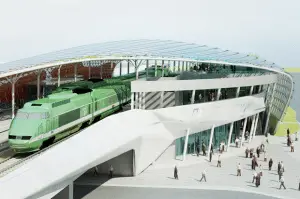
The Moscow Ring Railway should unify Moscow’s various transport systems. It should be integrated with the Moscow Metro, giving passengers yet another circle line to use to transfer between lines and thus clearing congestion in the center of the metro. The Moscow Ring Railway and the Moscow Metro will be connected in one system with one ticket. Transferring from one to the other will be free.
Timur Bashkaev,
Head Architect of the Moscow Ring Railway Corporation
When the Moscow Ring Railway was being built, there was not even talk about the subway. Where the Ring was built was entirely industrial, so there was no need to build a subway there. Because of this, nowhere are the railway stations and subway stations close to each other. If subway stations are near the railway, this is just a coincidence. Where it is possible, we will move the railway terminals closer to the stations. We have designed it so that the distance between the two is between 275-325 yards. The longest distance to walk between the two will be 875 yards.
In some areas, the Moscow Ring Railway overlaps the proposed second circle line of the Moscow Metro, currently under construction. However, the Moscow Ring Railway is in the shape of an egg pointed north, and the subway ring will be like an egg pointed south. Moreover, on this map the distance between the two rings looks not very big, but in reality the distance is several kilometers.
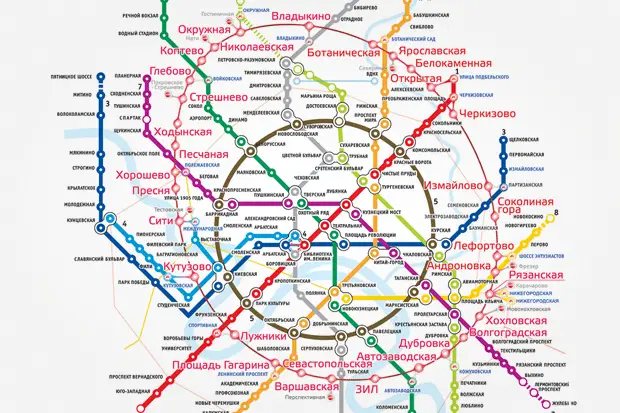
The Moscow Ring Railway will connect with the commuter trains which travel to Moscow’s suburbs and which spoke out from the city center in a wheel formation. People traveling from Moscow to the suburbs won’t need to travel to the city center to connect to their destination subway line. The Moscow Ring Railway will also connect all the commuter trains lines in a ring. It is still unclear if the commuter trains will also be combined with single-ticket system for the subway and ring railway.
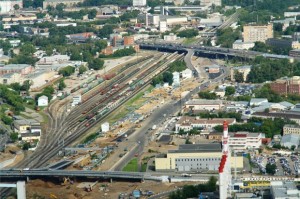
Alexei Zotov
First Deputy/Assistant to the General Director of the Moscow Ring Railway Corporation
Development of the Moscow Ring Railway would have been impossible without the development of the commuter trains. A decision about the trains’ timetable was made not long ago, to emphasize reducing the intervals between train arrival times and the number of service breaks for trains traveling in every direction. (Now, passengers and freight can travel on the same rails at the same time.) In light of this, launching the Moscow Ring Railway is all the more important.
As with the subway, we will move some Ring railway stations so that transfers between commuter trains will be more convenient. After the addition of the timetable and launch of the Ring, our system will be similar to Berlin’s mass transit system.
The Moscow Ring Railway runs through largely industrial areas of Moscow, located between the center and outer suburbs. With the appearance of this major new transport route, this now under-used area will receive a boost in development.
Timur Bashkaev: “Developing this industrial area is of course not a task of the Moscow Ring Railway. We do not do development work; we will only do the first step—bringing in a modern transportation system. But, we hope that a revitalization of this area will follow, as it is currently in a terribly depressing state.
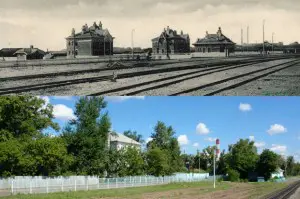
The Moscow Ring Railway was originally two railway tracks, both used for transporting cargo. A third track has been added around the entire ring. One track is used for cargo transportation to meet the needs of industries that still operate there and the two others will be used exclusively for passengers. The train moves with minimal intervals, which will run as low as five-minutes at rush hour.
New routes for aboveground public transportation have been developed to make it easier to reach the ring stations. Next to every transportation hub, there will be parking lots and bus hubs.
The Moscow Ring Railway was also electrified to allow the old diesel trains to be replaced with modern new electric trains.
Alexei Zotov: “Trains should be functionally similar to the subway trains: passengers should be able to embark and disembark in not more than 30 seconds. Otherwise, it may take up to 2.45 hours to travel the ring, and we foresee the entire route taking 45 minutes.
The interior of the wagons will be similar to those on the subway. Trains will be fitted to carry goods and bicycles. Another important requirement is the ability to walk between the wagons. We have prepared the specifications and have received several offers from foreign and Russian companies, but still have not chosen a contractor to construct the wagons.”
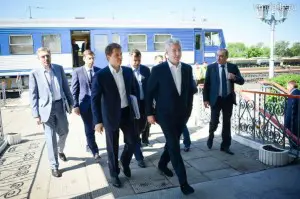
Cultural Legacy
Famous architects designed and constructed the majority of stations in the 20th Century – before the Moscow Ring Railway was formed. Many of these buildings still stand, largely because the Moscow Ring Railway was closed off from ordinary people and these stations were not of interest to investors. Now, cultural heritage experts are studying these stations and establishing conservation zones for each.
Irina Krimova
Director of Mosproekta-2 Studio #20
We plan to use the stations within the new project, but they are very diverse. The majority has been preserved very well but do not fit modern transportation needs. However, we hope that they can find some use. It would be awesome to enjoy these old buildings while riding the trains. There are also old warehouses and small buildings where station workers lived. In general, the territory of the Moscow Ring Railway is currently a very curious scene. For the most part, they are abandoned or surrounded by factories and industrial plants, but in some places, you can observe what a typical Moscow suburb looked like at the beginning of the 20th century.
Alexei Zotov: “Part of the historical buildings will be used for administrative needs. But a large part of them passengers will never see. In many places, the platforms will have to be moved, and nobody will transfer the buildings, of course. As requested by local residents, we will also have to install noise-barriers virtually the entire length of the railway which will also hide the stations from sight.”
More Pictures of the Moscow Metro
By various SRAS students
You Might Also Like
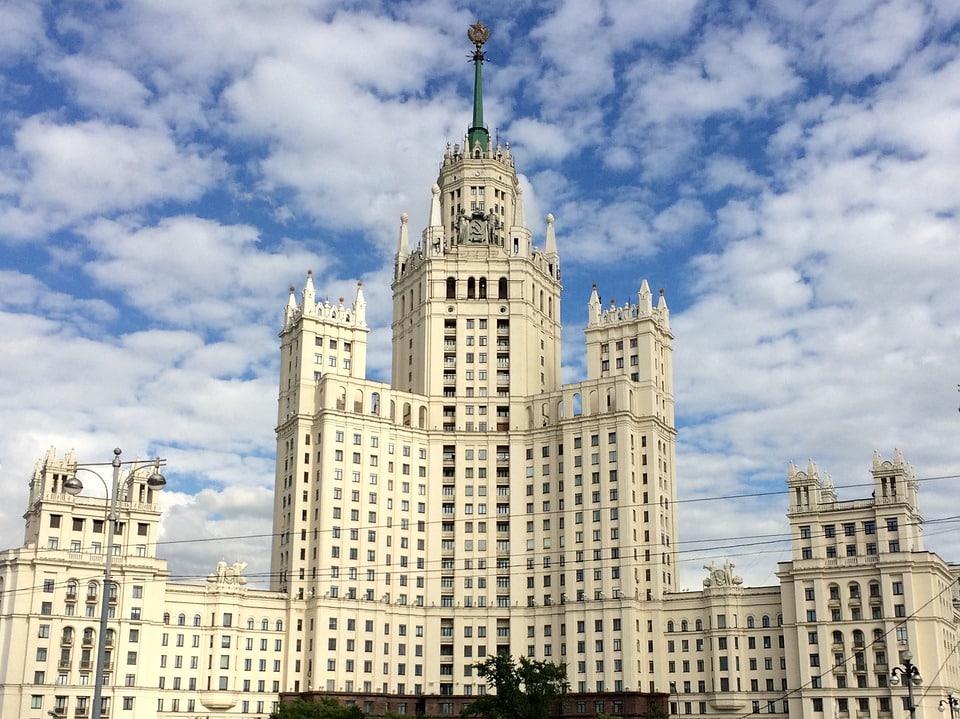
Moscow’s Seven Sisters – A Short History of Stalin’s Skyscrapers
Moscow’s skyline is largely defined by the seven towering skyscrapers nicknamed “The Seven Sisters.” Also known locally as “Stalinskie Vysotki” (Сталинские высотки – Stalin’s Highrises), they are one of the leading architectural legacies of the Stalinist period. The Soviet Baroque architecture that The Sisters embody is seen by some as unattractive; the buildings themselves are […]
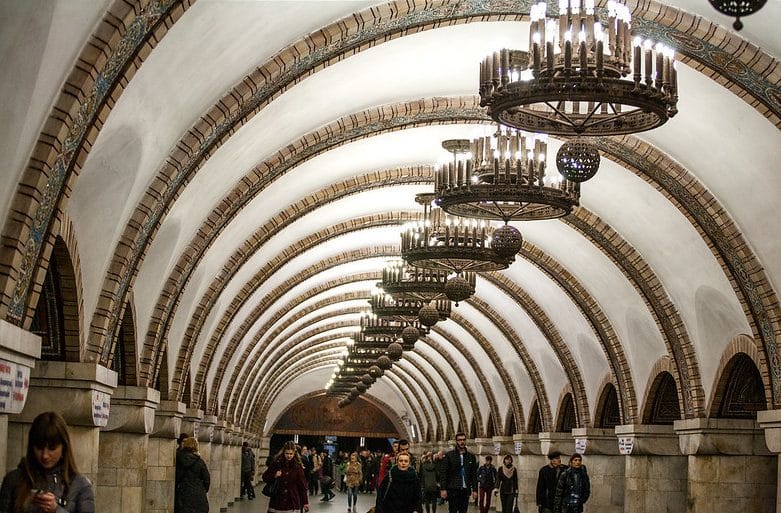
History of the Kyiv Metro System
Carrying well over a million passengers per day across 52 stations, Kyiv’s metro system is an integral part of the city’s daily life. While it has developed with the ever-growing city, like much of Ukraine’s public infrastructure, the metro system has struggled to keep up with the demands made of it. These demands are growing […]
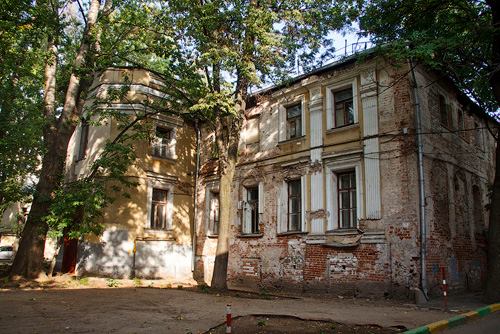
Moscow’s Seven Oldest Buildings
The following information was taken from a Facebook post by Москва и Москвичи. It has been translated here by SRAS Home and Abroad Scholar Caroline Barlow. Some explanatory text (in italics) and hyperlinks to further information have also been included for those readers who are not well versed in the history of Moscow and Russia. […]


